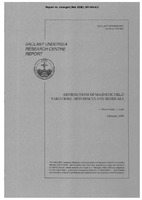Distributions of magnetic field variations, differences and residuals

Abstract
Temporal and spatial variations of the geomagnetic field were recorded in different geographic areas, using arrays of seven tri-axial magnetometers on the sea bottom at 50-150 m depth for periods of up to 16 days. The different geographic areas are characterized by different levels of the mean ambient magnetic noise. We discuss data from a magnetically quiet area and then focus on a coastal zone highly disturbed by anthropogenic magnetic fields, in particular by noise from an electrified railway line. In the latter area, the spatial uniformity of the ambient magnetic field is rather poor and the correlation between adjacent sites lower than in the former one. Simultaneous magnetic field observations from pairs of neighbouring magnetometers are analysed and compared. We compute first vector differences of the magnetic variations measured at neighbouring sites, and subsequently vector residuals. The residuals are those contributions to the magnetic field variations which are not correlated between adjacent sites and which can not be represented through a linear trivariate model. In the magnetically quiet area, we find that the magnetic field residuals are of the order of the system noise for magnetometers with about 1 km spacing and slightly higher for those with 12 km spacing. The area lends support to the application of a Remote Reference Technique, i.e. a technique in which the ambient magnetic field is compensated for by using measurements from a remotely operated reference sensor. "Remote" means that the reference sensor is sufficiently distant not to be influenced by the magnetic field of a ship navigating in the vicinity of the surveillance magnetometers. Although the magnetic field variations in the highly disturbed coastal zone are several times greater than typical magnetic field variations of natural origin, and also spatially non-uniform, we find good linear correlation between adjacent sites. This is demonstrated by the often rather small magnetic field residuals. However, in order to achieve small residuals, the spacing between the magnetometers must be an order of magnitude smaller than in the quiet zone. This may require the use of a Local Reference Technique for compensation of the ambient magnetic field. In a Local Reference Technique, the reference sensor must be so close to the surveillance sensors that it, too, is influenced by the magnetic field of the submarine navigating in the vicinity of the surveillance sensors. In the coastal zone, we find that the residuals of the vertical component of the magnetic field variations remain rather large. The coast-perpendicular component of magnetometers at equal distance from the coast yields the smallest residuals, i.e. they yield the best compensation of magnetic field variations when using a reference technique. The intensity distribution of magnetic field variations observed at the various sites strongly suggests that a significant part of the electric leakage from the railway system flows out into the sea up to several kilometres from shore. In summary, we find that magnetic field variations in the southern Ligurian coastal zone are dominated by magnetic railway noise which results in an anisotropic distribution of the spatial correlation between spaced sites.
Report Number
SR-304Date
1999/02Author(s)
Watermann, Jürgen
; Lam, J.